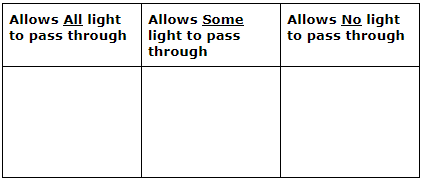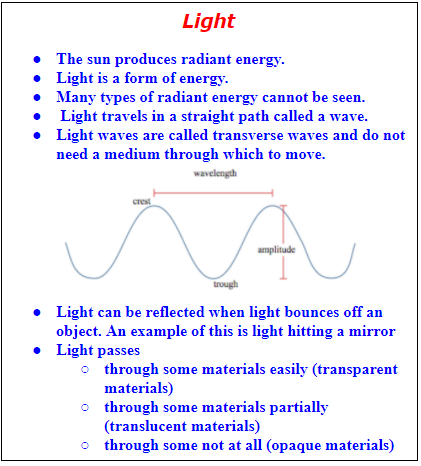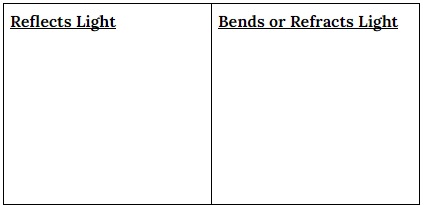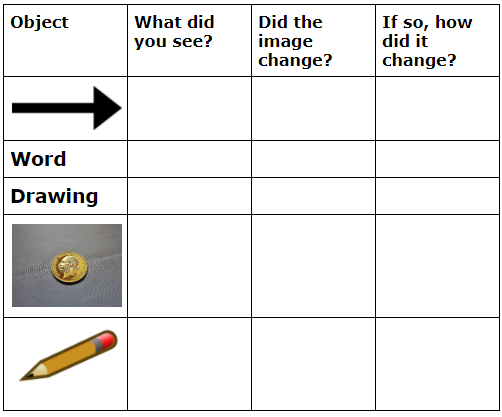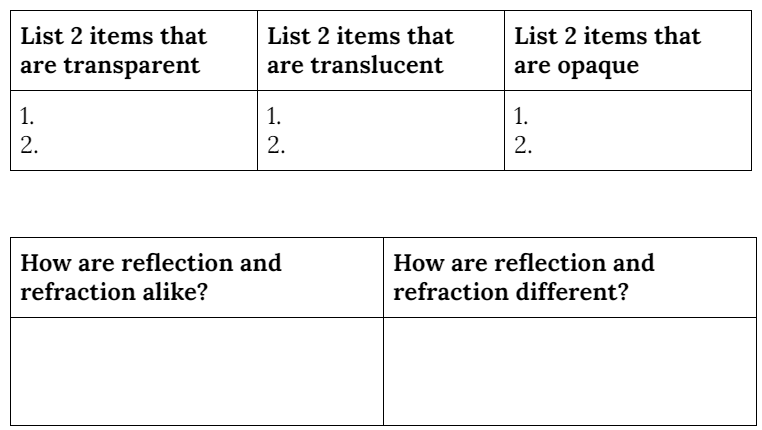Light
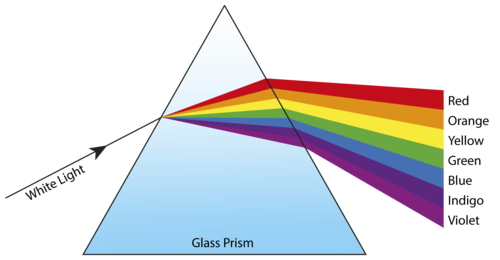
Overview
This module is designed to guide students in better understanding light. The students will also understand how light travels and interacts with other materials. The teacher will facilitate students' explorations as they generate a summary of their experiences. Throughout this unit, students will be guided in using practical materials such everyday items found in their classroom and light energy produced by flashlight
The goal of this module is for students to explore light and to better understand how it behaves. This module has been designed for 5th grade students or students who are developmentally ready to explore light. This module could also be used as a review for students in upper grades who need to build their fundamental understanding.
This module was developed by Sarah Donnelly, Stephanie Hooks & Karin Kaerwer as part of a Virginia Commonwealth University STEM initiative sponsored by the Virginia Department of Education.
Introduction
This module is designed to guide students toward a better understanding of light. It is designed to help students better understand how light travels and interacts with other materials. The teacher will facilitate students' explorations as they generate a summary of their experiences. Throughout this unit, students will be guided in using practical materials such everyday items found in their classroom and light energy produced by flashlight
The goal of this module is for students to explore light and to better understand how it behaves. This module has been designed for 5th grade students or students who are developmentally ready to explore light. This module could also be used as a review for students in upper grades who need to build their fundamental understanding.
The primary objective of this lesson is:
Explain that visible light is radiant energy that moves in transverse waves and that matter influences the path of light.
Materials:
- Flashlights
- Batteries
- Small mirrors (1 for each group)
- Clear glass
- Water
- Aluminum foil
- Triangular prism
- Rope
- Tall glasses or jars
- Coins
- Pencils
- Paper
Engagement
What is Light?
As the teacher, you should begin this experience by presenting a flashlight and asking the students to remember what they learned about electricity and circuits. The flashlight functions when the circuit is closed in order to light.
Turn the flashlight on and lay it on the table to shine on the wall. Have one of the students to turn off the lights.
Ask:
- What do you think will happen if we put our hand over the flashlight?
- What do you think will happen if we stand in front of the flashlight?
- What might happen if we were to put the glass vase in front of the flashlight?
Give the students time to discuss these questions with their classmates in their group. The students will then be given an opportunity to share their responses with the class.
When ready, show the follolwing and ask the students to consider how it may help them better understand light and any concepts that arose from the previous discussions:
After the students watch the video, assign them to groups of two or three.
Exploration
Discuss the following questions with the class:
- How does light interact with different materials?
- Can you share any of your experiences with light and how it interacts with different surfaces and materials?
Connect responses to these questions with the content from the video.
Using this information, begin to create an anchor chart:
Now the class will explore the question How does light behave?
Have the student groups discuss the following questions about flashlights:
- What will happen if we put our hand over the flashlight?
- What will happen if we stand in front of the flashlight?
- What will happen if we were to put the glass vase in front of the flashlight?
Using the flashlight, have the students in their groups conduct an investigation. They will select 6-8 different items from the classroom or their desks to test. They will shine a flashlight on these objects to see if all, some, or none of the light will pass through the object. Data should be recoreded in a simple chart:
As the students test the objects, they will write them down in the correct column on the chart.
Once all of the groups have conducted their investigations, they should discuss these findings as a class. Ask:
- What did you discover in your investigation?
- Did any of your findings confirm your previous experiences?
Explanation
How does light travel?
Remind the students that they tested various objects to see if some, all or none of the light from their flashlights would pass through. SHow the following video as a review:
Ask two students to come to the front of the room. Explain that the rope represents a light wave. Ask each student to take one end of the rope. Instruct the students to move the rope up and down hitting on the ground. As they do this, explain that each ripple represents a wave. The highest point is the crest and the lowest point is the trough. Then ask the students to move the rope faster. Ask:
Will the differences in movement change as they relate to frequency?
Connect observations to the following qualities of light:
Explain to the students that the video introduced a new term: refraction. Refraction is the bending of light. Since light travels in a straight path at a very fast speed it will bend or refract when it travels through certain materials. This is different from what was observed earlier. The next activitiy tests this theory.
Explain to the students that they will conduct another investigation using a flashlight and the following materials:
- Aluminum foil
- Metal spoon
- Triangular prism
- Crystal
- Rectangular prism
- Mirror
As they conduct their experiment, they will shine the flashlight on the objects to see if the light reflects or bounces off the surface or if it bends as it passes through the object. Record observations in a data table:
After the class finishes their investigation, guide the students to gain a deeper understanding of light by asking them several questions:
- How did you know that an object reflected light?
- How did you know that an object refracted light?
- What do the objects that reflected light have in common?
- What do the objects that refracted light have in common?
Elaboration
Elaborate on what has been explored by conducting the following investigation:
1. Divide the students into groups of 3 or 4.
2. Each group receives a clear tall glass or jar filled with water.
3. The goal of this challenge is to experiment with refraction through water. Ask:
Will the appearance of objects change when viewed through water?
4. Provide the students with 1 coin, 1 pencil, and 3 blank pieces of paper.
A. On their blank pieces of paper, each student is directed to draw an arrow on one, write a word on one sheet, and create an illustration on one.
B. Once the sheets of paper are completed, the students will place each sheet on one side of the glass and look at it from the other side of the glass. Ask:
What do you see? Did the image change? If so, how?
C. The students will then place the pencil in the glass. Ask:
What do you see? Did the image change? If so, how?
D. Last, the students will place the coin in the glass. Ask:
What do you see? Did the image change? If so, how?
Evaluation
Light evaluation questions:
Review
Light is a form of radiant energy.
Light travels in straight rays called transverse rays.
Light does not need a medium to pass through in order to be transmitted.
Light will behave differently as it passes through different mediums.
Light can be reflected when light bounces off an object. An example of this is light hitting a mirror.
Light passes through some materials easily (transparent materials), through some materials partially (translucent materials), through some not at all (opaque materials).
Additional Resources
For more information about Virginia Commonwealth University's School of Education STEM initiatives, visit the Center for Innovation in STEM Education (CISTEME).

